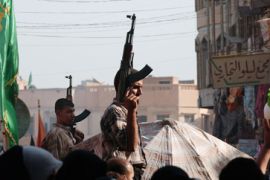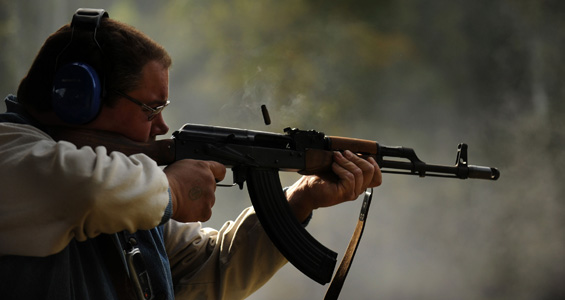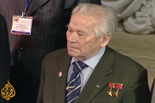Resistance icon or killing machine?
As the AK-47’s inventor turns 90, his influential gun still sparks mixed feelings.

 |
| One of five weapons on the planet is an AK-47 or a copy [GALLO/GETTY] |
It may have become a weapon of choice due to its lack of complexity, but the world’s relationship with the AK-47 is anything but simple.
A killing machine responsible for a quarter of a million deaths a year in conflicts from Afghanistan to Central America, its instantly recognisable silhouette figures in the consciousness of people in even the most peaceful countries.
It has been used to suppress pro-democracy movements, to overthrow governments, to resist occupations and to commit gangland murders. In the 60 years it has been in use, it has also become the most common firearm in the world; one in five of the guns on the planet is a Kalashnikov, or a cheap copy.
During that time, the AK-47 has become more than a gun. With its cheap, simple and reliable design, it has become a metaphor for the conflicts in which it has been used.
| In Video |
|
|
These have often pit small, loosely-organised groups against a superior fighting force. As a result of their successes, the Kalashnikov has become an icon of resistance, a testament to the triumph of determined simplicity in the face of the high-tech weaponry and tactics of modern armies.
It wasn’t always this way. The first time the AK-47 was used in anger, it was the high-tech weaponry of its day. Issued to the Russian Red Army in 1949, it was used to put down protests against Stalinist policies in the Hungarian Uprising of 1956.
Some 2500 Hungarians, many of them unarmed, were killed by Soviet troops. The Kalashnikov’s status as the weapon of the people was some way off.
Effective weapon
It was the decision of the Soviet Union to license friendly countries to produce their own versions of the AK that enabled its rapid spread. Counterfeiters began to copy it, impressed by its lethal simplicity and low production costs, and its users were pleased with its reliability.
Even the Soviet Union’s enemies acknowledged the effectiveness of the weapon. In Vietnam, the AK was used to kill US soldiers, but it was also used by them, stripped from the bodies of dead Viet Cong and preferred to the unreliable M-16, which had an unfortunate habit of jamming in combat.
|
“Around the world babies are named Kalash as a symbol of liberty” General Mikhail Kalashnikov, inventor of the AK-47 |
Before long the use of the weapons had fallen out of Soviet control; AK-47s were available to whoever wanted them.
They were even used against the Russians themselves, when, in 1982, the Israelis captured a cache of Kalashnikovs in Lebanon which they funnelled, at the behest of the US government, to the burgeoning resistance movement fighting the Soviet occupation of Afghanistan.
Today, the same guns are being used by the same people to kill US troops in Afghanistan, and Israel has been forced out of Lebanon by Hezbollah, a Shia resistance group established in opposition to the occupation. On the Hezbollah flag is a familiar silhouette – that of the AK-47.
Ambivalent status
The gun’s designer, Mikhail Kalashnikov, who celebrated his 90th birthday this week, recognises the devastation caused by the gun, famously saying he wished he had invented a lawn-mower. But he refuses to condemn the weapon itself, only criticising those who use it.
“I am happy to know that in many countries around the world babies are named Kalash as a symbol of liberty won in the struggle for independence and democracy,” he told the United Nations in 2006.
“But at the same time it pains me to see that various counterfeits bearing my name are falling into the hands of thugs and terrorists.”
That speech captured the ambivalence with which the AK-47 is regarded around the world. It is an ambivalence borne of a fact as simple as the workings of the rifle itself; that while one man’s terrorist is another man’s freedom fighter, the gun they use is the same.
